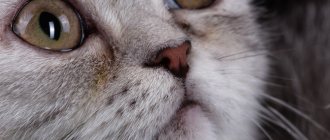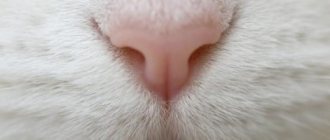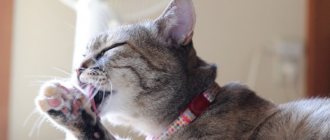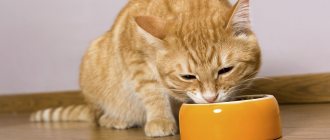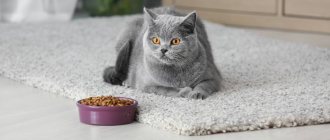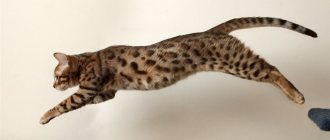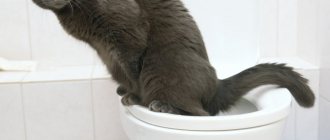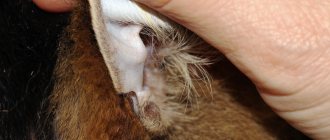Even people who have never had pets know very well that a cool, moist nose is an indicator of the health of the animal. The desire of cat owners to understand whether they should be concerned if the olfactory organ is warm and dry is understandable. Many diseases are accompanied by an increase in body temperature, at which this phenomenon occurs. But even a completely healthy cat can have a dry and warm nose. You need to be able to distinguish the symptoms of the disease from natural, safe changes in the temperature of the olfactory organ. This will help you take effective measures in a timely manner and avoid unnecessary concerns.
Natural causes of a warm, dry nose in a cat
In cats, the nose is the most important organ. Its functions include not only capturing and identifying odors. A wet nose allows the animal to accurately determine the direction of air currents. This allows you to find out the location of the source of the smell or hide your presence from the object of the hunt. If the nose dries out, it cannot perform this function. In order to maintain the organ in normal condition, special glands produce mucus to create a protective shell that prevents drying out. In addition, the cat regularly licks its nose, keeping it moist. This organ is also one of the components of the thermoregulation system. Evaporation of moisture lowers body temperature. Therefore, when a cat is hot, he licks his nose more often.
An increase in temperature and drying out of the olfactory organ can occur for natural reasons not related to disease. This phenomenon should not cause concern if the cat:
- just woke up or is sleeping;
- spent a lot of time in the active sun or near a heating radiator;
- experienced severe stress;
- played a lot.
If your pet overheats in the sun, near a radiator, or during long games, its body temperature will be restored quickly without outside help. During sleep, the cat does not lick its nose, so it dries naturally. The cause of an increase in the temperature of the nasal planum may be contamination of the nasal passages. It is necessary to examine the pet and, if necessary, clear the sinuses. If your cat's nose is warm and dry, you should definitely check the condition of the ears. As their body temperature rises, they also become hot.
Owners of kittens should know that babies’ thermoregulation system is just developing, their nose may be warm not due to illness, the body thus prevents hypothermia of the body. Dryness and increased temperature of the nose persist in the cat after birth. This is a normal phenomenon, the body will gradually return to normal without veterinary care.
What are the signs that require contacting a veterinarian?
If the following symptoms are detected in a kitten, you should consult a veterinarian to identify the causes of your pet’s illness:
- malaise, lethargy, apathy;
- dry and hot nose;
- cold and pale nose;
- change in organ color (blue, yellowish, red, white).
The owner should know that a pale and cold organ in a kitten is a sign of:
- chronic illness;
- hypothermia;
- stress;
- low body temperature;
- poisoning;
- complete lack of appetite.
A white and warm nose is a sign of a disruption in the kitten’s circulatory system. The blue and hot organ talks about:
- heart failure;
- inflammation of the respiratory organs;
- oxygen starvation.
When a kitten has a hot and red organ, this is a sign:
- infectious disease;
- rhinitis;
- mechanical damage.
If a kitten has a hot, dry nose and warm ears, then this is not necessarily a sign of illness, because heat exchange has not yet been established in babies, and their body temperature is higher than that of an adult pet. This may be due to the work of the body and its protection from hypothermia.
Warm, dry nose as a symptom of the disease
Increased nasal temperature and dryness that occur due to natural causes do not persist for a long time. Quite quickly the organ of smell returns to its normal state. If the signs do not go away, you need to carefully monitor your pet. The disease usually causes several symptoms. Along with an increase in temperature, the following symptoms may appear:
- lethargy, apathy, lack of appetite;
- long, uninterrupted sleep;
- heart rhythm disturbance, tachycardia;
- strong thirst;
- slow breathing;
- sneezing, mucus discharge from the nose;
- nausea, vomiting, diarrhea;
- anxiety, restlessness;
- knocked down, dull, disheveled wool, etc.
If these symptoms appear, the cat must be shown to a veterinarian, the cause of the ailment must be determined, and effective treatment must be started immediately.
You need to pay attention not only to the temperature and dryness of the nose, but also to its color. If it is warm and pale, there are disturbances in the functions of the circulatory system and hematopoiesis. A bright pink color may indicate the presence of infection; a bluish, purple tint appears with oxygen deficiency, inflammatory processes in the lungs, or poisoning. Liver failure leads to yellowing of the olfactory organ.
Alarming symptoms
A cat's hot, wet nose is not a symptom in itself. If you monitor his temperature throughout the day, you can notice significant fluctuations in his condition. This does not mean that the cat is sick and needs medical attention.
Concern should arise if changes occur in your pet's behavior. In this case, you need to carefully consider the condition of the animal and note any deviations from the normal condition. They will help in the future to identify why the cat has a very hot nose.
Signs that may indicate illness:
- apathy;
- lack of activity;
- lack of appetite;
- refusal to drink;
- nasal discharge;
- sneeze;
- redness of the eyes;
- aggressive behavior;
- irritability;
- desire to hide;
- refusal of contact and games.
Before contacting a veterinarian, you need to exclude stress factors, heat or cold, and the presence of allergens, which can also lead to such behavioral reactions in a cat or kitten.
The main reasons for the rise in temperature
Fever is a common symptom. There are many cat diseases that are accompanied by this symptom. Only a veterinarian can make an accurate diagnosis after examination. The most common causes of fever include:
- accumulation of hair in the intestines, stomach;
- formation of stones in the kidneys and bladder;
- dehydration due to illness or conditions;
- inflammation and infections;
- digestive disorders, poisoning.
Any of these diseases requires professional diagnosis, treatment, selection of drugs and doses.
It is necessary to pay attention to the prevention of diseases and reduce the risk of their occurrence. In order to prevent the accumulation of hair in the digestive organs, you need to purchase special food at the pet store and sow grass that removes hair from the body. Sometimes overeating leads to disruptions in the gastrointestinal tract. If the cat has an excessive appetite, the amount of food should be controlled.
Banal reasons why a cat is lethargic
To begin with, let’s agree that the reasons why a cat has become lethargic can be quite banal. So, the animal will look apathetic in the heat
when the air temperature outside the window and in the room is above +30 degrees.
A pet that is tired or has eaten a hearty meal
.
And there are simply phlegmatic cats
, which almost always look too calm and sleepy.
The following picture is also not uncommon: an old cat constantly sleeps and is lethargic. And it’s not at all necessary that the pet is in pain, it’s just that there is not enough strength left for cheerfulness
, no matter how sad it may be.
Cats often behave very calmly and even lethargically after estrus.
, more precisely, after mating, if there is a result of successful mating with a cat in the form of pregnancy. During the first 3-4 weeks, the expectant mother cat sleeps a lot and eats little (or a lot), which should not cause much concern to the owner.
In addition, medications prescribed by a veterinarian
(for example, the same antihistamines or sedatives).
Also, for 1-2 days the animal is unusually calm and inactive after anesthesia
, while the drugs used for anesthesia are removed from the body.
Ways to provide assistance
If a cat’s nose becomes hot and dry without natural causes, this phenomenon does not go away for several hours, there are other negative symptoms - the best help for your pet is to call a veterinarian. It is quite difficult to determine the cause without qualifications. Independent choice of treatment often leads to serious negative consequences.
Cat owners need to remember that their pets should not be given antipyretics from their first aid kit. Paracetamol, Aspirin and other drugs are very dangerous for animals.
It is not always possible to make an urgent visit to a veterinary hospital; sometimes you have to wait a long time for the doctor to arrive. At this time, you need to provide first aid to your pet to alleviate its condition. The main danger at elevated temperatures is dehydration. The cat needs to be given cool water. If the animal cannot drink on its own, you can add a little water with a syringe. Long-haired pets can additionally be sprayed with a spray bottle. Pets without hair should be wiped with a damp cloth.
The first step is to measure your body temperature rectally. If it does not exceed 39.5°C, there is no need to knock it down before being examined by a veterinarian. But it is advisable to reduce the higher heat. To do this, you need to wrap an ice pack in a cloth and apply it in the armpits, groin, and head. You cannot cool one area for a long time.
Additional symptoms, their explanation and what the owner should do
As we just said, a dry nose alone does not indicate much. Therefore, we list additional symptoms and their explanation. And we’ll also tell you what the breeder should do when they appear.
Nose is very hot
If the nose is very hot (so much so that the hand feels it immediately), and the kitten itself looks “smeared,” things are bad. With almost 100% probability, the baby has an extremely elevated general body temperature, and he must be shown to the veterinarian immediately. This often happens in kittens with viral infections, and they are deadly for young animals. Here's what you can do:
- Place the kitten in a well-ventilated room (but without drafts), the air temperature should be within 20°C.
- Give the animal plenty of drink, to which you can add a little sugar.
- Call a veterinarian.
There is no need to give any “human” antipyretics! For example, any paracetamol-based products are lethal for cats.
Nose is very cold
If the nose is very cold and dry, then this is also not very good. This can happen when:
- Very severe intoxication of any origin.
- For sepsis.
- In the terminal stages of many infectious diseases.
- With intermittent fever, when the body temperature “swings”, with a sharp increase and decrease.
In all these cases, not only the nose is cold, but the whole body. Often, such a sharp drop in temperature indicates a complete failure of the thermoregulation center in the brain. It often precedes the death of the animal. It is necessary to place the animal in a warm place (but not in the heat) and urgently call a veterinarian. It is unlikely that you will be able to do anything on your own.
Dry nose while sleeping
As we have said many times, a dry nose during sleep is completely normal, there is no need to panic. If it comes to a city apartment or other housing with central heating, it is worth checking the air humidity in the room.
If it is too low, we advise you to purchase an air humidifier or simply start an aquarium.
Kitten sneezes
If a kitten sneezes and has a completely dry nose, the symptom may indicate:
- Infectious diseases of the upper respiratory tract. As a rule, mucus or some kind of exudate is released from the nasal passages.
- This happens when the room is dusty and stuffy.
- Possible allergies.
- Sometimes this indicates the presence of foreign bodies. In this case, mucus may be released abundantly from the nose, and it often contains blood impurities.
The pet must be placed in a ventilated, cool room. If the reason is dust, that's enough. If snot runs out of the nose, it needs to be cleared of exudate and dried crusts using warm saline and the smallest syringe with a long rubber tip. And in this case, and if a foreign body is suspected in the respiratory tract, a veterinarian is again needed.
In case of allergies, the baby is given up to ¼ tablet of diphenhydramine.
The kitten doesn't eat anything
When a kitten does not eat anything and has a completely dry nose, then this is 100% a sure sign of some kind of disease. One can only guess about the reasons for it, and therefore it is better to immediately consult with a specialist.
You can try to “cheer up” your baby by using tasty pieces of soft food or meat. If the kitten begins to eat, he is also given plenty of clean and fresh drinking water. Otherwise, a veterinarian is still required, since the kitten’s body will not last long without food and drink.
Lethargic kitten
When a kitten is lethargic and has a dry nose, this almost always indicates an infectious disease; this happens when the pet is severely overheated. In these cases you need:
- Place the pet in a room with normal air temperature, if necessary, involve a veterinarian.
- Provide the kitten with complete rest, selected natural or canned food (to stimulate appetite) and plenty of water.
Treatment of acute respiratory infections in children, effective relief of symptoms
Recommendations on how to treat acute respiratory infections in children are aimed at relieving clinical manifestations associated with the inflammatory reaction.
Recommendations on how to treat acute respiratory infections in children are aimed at relieving clinical manifestations associated with the inflammatory reaction.
- a diet rich in vitamins;
- drinking plenty of water;
- antipyretic drugs.
Locally, symptoms are relieved by the following means:
- for nasal congestion - with vasoconstrictor drops;
- if the throat is affected - with sprays, local antiseptics, gargles;
- to relieve a wet cough - with expectorants;
- for dry cough - antitussives. Source: T.A. Samsygina Modern treatment of acute respiratory diseases in children // Pediatrics, 2013, No. 3, pp. 38-42
Inhalations and physiotherapy may also be prescribed.
Antibiotic treatment for acute respiratory disease is prescribed to children when the causative agent is a bacterial infection; only a doctor should give clinical recommendations, select the drug and dosage. If a child is prescribed an antibiotic for the flu, it is necessary to relieve complications that arise from bacterial damage (for example, pneumonia). In general, antibacterial drugs are powerless against viruses.
Doctors recommend avoiding antibiotics for uncomplicated respiratory viral infections. Their use is not justified even with mucopurulent runny nose lasting less than 2 weeks. Source: Seto WH, Conly JM, Pessoa-Silva CL et al Infection prevention and control measures for acute respiratory infections in healthcare settings: an update // East Mediterr Health J., 2013, i9 (Suppl. i), p. 39-47
Signs of a bacterial infection for which antibiotics are indicated:
- anaerobic sore throat;
- purulent processes;
- acute tonsillitis when group A streptococcus is detected;
- sinusitis, if clinical changes persist in the sinuses after 2 weeks from the onset of the disease;
- acute otitis media;
- pneumonia;
- chlamydia and mycoplasmosis (respiratory form);
- bronchitis caused by mycoplasma (mycoplasma bronchitis).
The child is required to have bed rest
until body temperature normalizes,
eat a balanced diet, take multivitamins
. You can gargle with decoctions of medicinal herbs, infusions, and antiseptic solutions. If the body temperature is normal, then the following will be useful: dry heat on the lower back and feet, hot foot baths.
How can I help if... the cat is healthy?
Or rather, if only his nose is unhealthy in some cases.
- The tip of the nose is dry because it is very dirty. This can happen when the owner does not regularly clean the pet. Sometimes pollution can cause difficulty breathing and a decrease in physiological lubrication from the inside, resulting in impaired thermoregulation.
It is enough to carefully clean the nasal passages inside and out, and after 20 minutes the pet’s condition will return to normal. - Occasionally, a burn to the nasal “mirror” occurs if the animal slept for a long time in the sun. The owner of a very delicate pink nose may especially suffer. First, the skin will become red, it will become hot, then it will become dry and rough. Help: treatment with an anti-burn drug, moisturizing and anti-inflammatory (do not allow it to get into the nostrils); if necessary, repeat the processing.
- An allergy or irritation to some kind of household “chemical” in your pet, who loves... to poke his curious snub nose everywhere.
If the drug gets on the face, wash the fidget. Do a wet cleaning of the room. Place products harmful to purring out of reach. Do not use them in his presence. Consult your veterinarian to find out what and how antihistamine medications to give.
There is only one last case left, which it wouldn’t hurt to find out about at the same time.
Prevention of acute respiratory infections and acute respiratory viral infections in children
Prevention of acute respiratory infections should include, first of all, protection in children from sources of infection with acute respiratory diseases
, during periods of epidemic, it is recommended to wear a medical mask in kindergarten and school. In addition, you must:
- provide the child with vaccinations on schedule and during the epidemic;
- avoid hypothermia;
- carry out hardening;
- feed the child correctly - in a balanced manner, according to a schedule, with food rich in vitamins;
- spend less time in public places during outbreaks;
- at the first signs of illness, consult a doctor, even if you need to miss school or kindergarten;
- walk more with your child in the fresh air;
- introduce general strengthening gymnastics into the child’s daily routine.
Sources:
- S.O. Klyuchnikov, O.V. Zaitseva, I.M. Osmanov, A.I. Krapivkin, E.S. Keshishyan, O.V. Blinova, O.V. Bystrova. Acute respiratory diseases in children (Manual for doctors) // Russian Bulletin of Perinatology and Pediatrics, 2008, supplement No. 3.2008.
- L.A. Balykova, Doctor of Medical Sciences, corresponding member. RAS, T.I. Razdolkina, candidate of medical sciences, associate professor. Acute respiratory diseases in children // Remedium Privolzhye, 2021, No. 3(163), pp. 18-22.
- T.A. Samsygina. Modern treatment of acute respiratory diseases in children // Pediatrics, 2013, No. 3, pp. 38-42.
- Seto WH, Conly JM, Pessoa-Silva CL et al. Infection prevention and control measures for acute respiratory infections in healthcare settings: an update // East Mediterr Health J., 2013, i9 (Suppl. i), p. 39-47.
Markova Daria Olegovna Clinic
Author of the article
Markova Daria Olegovna
Specialty: endocrinologist
Experience: 14 years
The information in this article is provided for reference purposes and does not replace advice from a qualified professional. Don't self-medicate! At the first signs of illness, you should consult a doctor.
